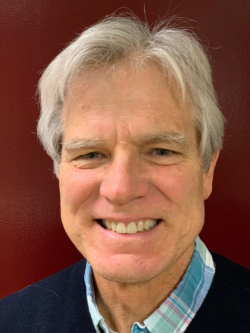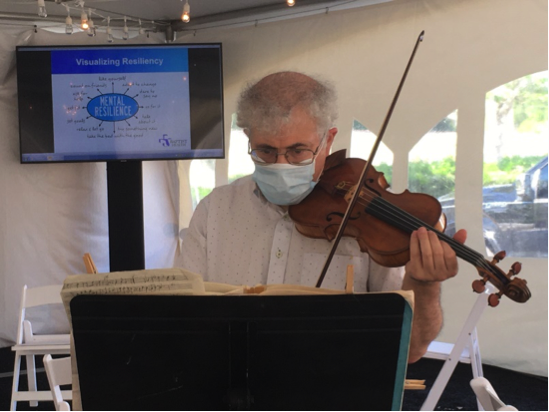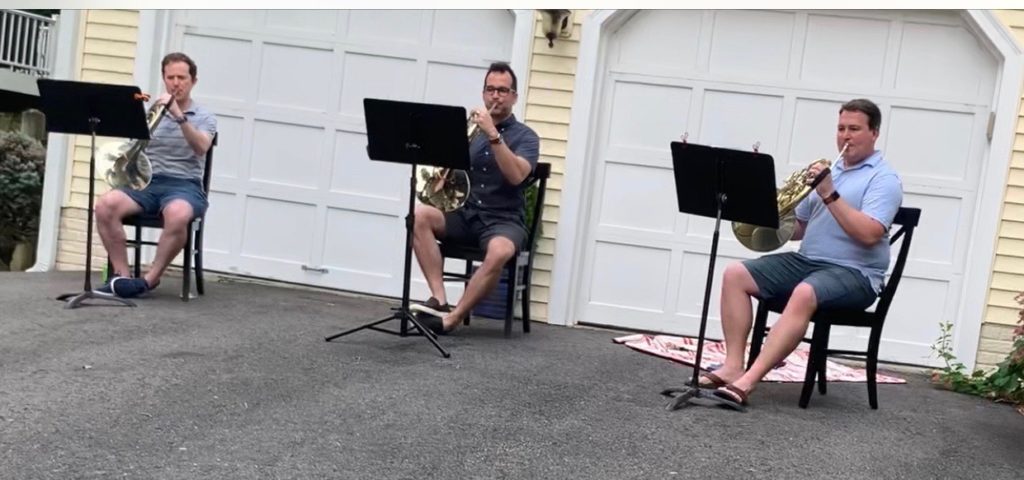
Photo credit: Brian Prechtl
The global health emergency caused by the novel coronavirus stopped life as we knew it in mid-March. The effects of COVID-19 have been a shock to all, performers and music lovers alike. Shut out of concert halls and denied the ability to be together physically, ICSOM musicians immediately harnessed their creativity. They have launched diverse initiatives to help fill the gaping hole that the absence of orchestra, opera, and ballet performances have left in our culture. They have continued making music, and they have increased social media outreach to audiences and supporters, adapting quickly and imaginatively to the new circumstances.
ICSOM musicians in many orchestras have worked cooperatively with their orchestras’ staffs to produce new online content, allowing more flexibility in the organizations’ ability to take advantage of various platforms to reach listeners. The AFM’s Symphonic Services Division’s Rochelle Skolnick and Deborah Newmark have helped make this possible through intense negotiations for a series of special side letters to the Integrated Media Agreement for this unusual period of time. Musicians and orchestra managements have made recordings and live streams widely available on social media, as well as on traditional media platforms.
One of the first and most ambitious types of projects to emerge was the creation of videos of orchestral works in which individual musicians recorded their parts from their own homes. More than 60% of ICSOM orchestras have produced at least one of the now familiar “gallery view” video recordings that can be viewed on Facebook and/or on YouTube. Musicians of the Indianapolis Symphony have created their own YouTube channel, called “Music in a Time of Distance” in recognition of the current period, featuring recorded excerpts from Beethoven and Dvořák symphonies. Minnesota Orchestra musicians released a video with Dessa, a local rapper/singer/songwriter, as part of a local fundraiser for arts organizations. Lyric Opera musicians produced “Ride of the Valkyries”, which made a cameo appearance at the League of American Orchestra’s online conference. Baltimore Symphony musicians recorded the final seven minutes of the Mahler Third Symphony, which they had been scheduled to perform beginning the day the lockdown in Maryland began.
These orchestral videos are often facilitated by creating and then sending a click track to all of the orchestra’s musicians, which musicians then use as they record their own parts. The engineering feat required to produce a high quality video, combining recorded content from various recording devices individual musicians use into a finished product, cannot be overestimated. Professional recording engineers and orchestra musicians have contributed their skills to these projects, in many cases pro bono.
But these types of projects were just the beginning. Detroit Symphony delegate Monica Fosnaugh reports that musicians and management have formed an Innovation Committee. That new committee, along with all musicians and staff, has come up with lots of ideas. Lyric Opera Orchestra’s delegate Amy Hess says, “At Lyric, we’ve developed a great relationship with the marketing department during the pandemic. They were thrilled to promote our ‘Ride of the Valkyries’ video, and we have also contributed content that they have crafted into blog-type articles (instruments of the Ring cycle featuring some of our old Facebook videos, cocktails based on the four Ring operas, a Spotify playlist of works featuring our musicians outside of Lyric, etc.).” Nashville Symphony Orchestra Committee Chair Melinda Whitley tells us that “many musicians . . . have now worked with our development department and made hundreds of phone calls to donors so far. The musicians . . . have over two dozen PR/social media type projects in various stages of production.” Baltimore Symphony musicians and staff have created a Digital Content Task Force to highlight volunteer efforts, to connect with donors, and to present musical content.

Andy Bruck (Jacksonville) plays for healthcare workers at Baptist Beaches Medical Center
Photo credit: Cynthia Kempf
Several orchestras have featured musicians live-streaming concerts and recorded solo and chamber music. In Baltimore, on the BSO’s Facebook page, Principal Oboist Katherine Needleman, Third Horn Austin Larson and Pianist Lura Johnson give new live concerts each week at the same day and time, as part of the “BSO Offstage” initiative. The Baltimore Symphony also live-streams concerts every Sunday at 3 pm, featuring a different BSO musician each week, and the BSO viola section produces a “Lunch Bachs” series each Wednesday, in which members of the viola section play movements of solo Bach cello suites, as well as solo viola music by Reger and Hindemith. The Milwaukee Symphony Orchestra Trio “ZYP” musicians, who were to perform one of their coffee shop concerts, instead recorded their Haydn trio and posted it to Facebook as a virtual coffee break.
Individual musicians are making recordings with colleagues or by themselves, sometimes socially distanced (standing several feet apart) and sometimes remotely, in which individual tracks are combined into a whole. There are too many instances to mention more than just one here: the creative arrangement, made by Detroit Symphony Orchestra bassoonist Marcus Schoon, of “Tears of a Clown”, in which he plays all four parts. (Former DSO Principal Bassoonist Charlie Sirard, who retired in 1977, was the musician on the original Motown recording made by Smokey Robinson and the Miracles.)
Detroit Symphony musicians have taken this approach one step further: There is a side by side quartet project in which community members play along with a DSO quartet and submit videos to be edited together. And in Milwaukee, violinists in 8th grade and younger during the 2019–20 school year are invited to submit a video of themselves playing Part I or Part II of the first movement of the Bach Double Violin Concerto for the MSO’s upcoming video compilation.
Connecting with audiences and donors has also been an emphasis of digital outreach. At the Lyric Opera, musicians have started a series on their own social media pages titled “Lyric Orchestra Rides It Out”, featuring heartwarming personal updates and affirmations of the importance of music. Similarly, Milwaukee Symphony musicians, whose social media committee has separate Facebook and Instagram teams, are producing fun videos and posts that often combine music with their everyday activities. Content on their social media platforms include such topics as home life, pets, gardens, cooking, hiking, and kids. Other activities, such as mask making, have also been documented. Activities for families such as coloring pages, musical journeys, and storyboard activities are provided on the Minnesota Orchestra Facebook page by Minnesota Orchestra at Home. And the Baltimore Symphony’s Lunch Bachs series always features violists’ non-musical activities in addition to the music: we can accompany them remotely on their runs; their children make occasional appearances; and we learn about their pets, and what BSO violists are reading and baking.
Educational and health/wellness activities abound. “Ohm at Home”, a virtual yoga class, is led by the Detroit Symphony librarian Ethan Allen, and features recorded music from DSO players, and there are educational postings and events on the Detroit Symphony’s Facebook page, as there are on the Facebook pages of many orchestras.
In Detroit and elsewhere, symphony musicians provide music and messaging supportive of first responders. Baltimore Symphony musicians now have a weekly series of live streams for Johns Hopkins Hospital medical professionals, and musicians have also live-streamed concerts for staff and patients at the University of Maryland Medical Center. Lyric Opera of Chicago musicians also are planning partnerships with local hospitals. In Minnesota, musician-led organizing resulted in a donation of $3,360 from the musicians to Second Harvest Heartland. The entire organization is working on a mask drive for community partners in need, with the goal of collecting 1,350 masks in May. And in Jacksonville, Local 444 president, and JSO violinist, Andy Bruck performed several times for caregivers at Baptist Beaches Medical Center as part of the hospital’s Rest and Revive program.

(l to r) Bob Rearden (National), Geoffrey Pilkington (Kennedy Center), and James Nickel (National) perform as part of a “porch” concert in Fairfax, VA
Photo credit: Julianna Nickel
Detroit Symphony musicians have produced dozens of “Play on Porch” videos of DSO musicians playing for neighbors for their homes, and for digital audiences everywhere. In the nation’s capital, several National Symphony Orchestra members and Kennedy Center Opera House Orchestra members have put on porch concerts as well, sometimes in collaboration with musical family members. St. Louis Symphony horn players performed an alphorn trio on a front porch, and posted it on “SLSOatHome”.
Musicians are making it easier for listeners to understand professionals’ musical thinking. “Between 2 Stands” is a new weekly web series that goes on a journey inside the minds of Detroit Symphony musicians. The Baltimore Symphony hosts a weekly “Virtual Governing Members Lounge” in which Music Director Marin Alsop, BSO staff members and musicians discuss various musical topics. The Detroit Symphony hosts Watch Parties, in which several musicians and the Music Director participate in live commentary while hosting a Facebook live broadcast.
Rochester Philharmonic’s ICSOM delegate and Fourth Horn Stephen Laifer reports that he and Principal Oboist Erik Behr started a Facebook group called RPO-WXXI 91.5 Broadcast Concerts. During WXXI’s re-broadcasts of last season’s RPO concerts (which are also streamed on the station’s website), the group has “textual chat via posts to the group page, though we will often also post photos of composers, soloists, etc.,” said Laifer. “For the Sibelius Violin Concerto, Augustin Hadelich joined us for a half hour, and the listeners loved it. We generally comment on the music, some historical tidbits, ask listeners to send in pics from wherever they’re listening, answer personal questions about RPO musicians, and generally poke light fun at each other. The object is to be somewhat informative, but mostly just entertaining. We’ve got a pretty big following in a short space of time, and as word spreads, people really seem to enjoy it. At last count we have over 1,100 members in just under a month.”
Orchestras in the U.S. and all over the world continue to seek the best scientific and medical advice, along with public policy guidance, as the coronavirus crisis continues. How and when will we be able to go back onstage to perform with colleagues, and when we do, how many audience members can safely attend? As ICSOM orchestras attempt to answer those questions, ICSOM musicians will continue to be at the forefront of efforts to provide beauty, solace, and excitement to music lovers everywhere, through both traditional media and more innovative methods. The desire to reach out with great music and make positive contributions to society continues to inspire these efforts.
Note: the author is an ICSOM Member-at-Large, and a member of the Baltimore Symphony Orchestra.





